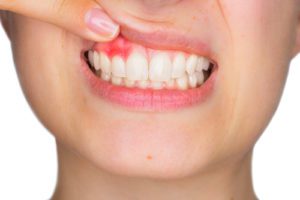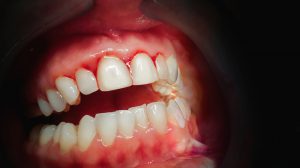Why do My Gums Bleed when I Floss?
 Surprisingly, this is not a question we hear very often. But it is a question that people frequently ask Google. Does that mean this is something you feel a little sheepish asking your dentist or dental hygienist? Do you feel like you will be chastised for having bleeding gums?
Surprisingly, this is not a question we hear very often. But it is a question that people frequently ask Google. Does that mean this is something you feel a little sheepish asking your dentist or dental hygienist? Do you feel like you will be chastised for having bleeding gums?
At Designer Smiles, nothing could be further from the truth! We welcome any questions about your oral health because we want you to be as healthy as possible. So just in case you don’t want to ask us this question at your next visit, we will answer it in this blog.
What Makes Gums Bleed in the First Place?
 You may have heard it said that “healthy gums do not bleed”. In general, that is a true statement. The reason gums bleed is inflammation.
You may have heard it said that “healthy gums do not bleed”. In general, that is a true statement. The reason gums bleed is inflammation.
Inflammation in the gums is the body’s natural response to plaque buildup on the teeth. Plaque consists of food debris, exfoliated tissue cells from the inside of the mouth, and most importantly, bacteria. The bacteria produce toxins, and it is these toxins that cause the inflammatory response.
One of the main things inflammation does is increase the blood flow to the site of injury. This is why inflamed areas are red, swollen, and may experience throbbing sensations. The increased blood flow is also why inflamed gums bleed so easily.
Severely inflamed gums can bleed when you floss, when you brush, or even when you simply chew food.
Why do My Gums Bleed when I Floss?
There are several reasons that flossing, in particular, causes gums to bleed. We have already established that healthy gums should not bleed. If there is an area of your mouth that consistently bleeds when you floss, that is an indication that this area is unhealthy. Here is why flossing is more likely to make your gums bleed than anything else:
More Plaque Buildup between the Teeth = More Inflammation
The area where two teeth touch creates the perfect hiding spot for plaque to build up. There is always more plaque between the teeth than on the smooth surfaces that face your lips, cheeks or tongue. Because of this greater amount of plaque buildup, which equals a higher level of bacterial toxins, there is more inflammation between the teeth.
Your toothbrush bristles cannot reach into the area between the teeth, so brushing alone does not remove plaque from the between-the-teeth areas. Only flossing can do that!
Inconsistent Flossing
We know that most people aren’t great at flossing every single day. When you only floss sporadically, you allow plaque, bacteria, and inflammation to build up between the teeth. Then when you do floss, the simple touch of the floss on the inflamed gum tissue can cause bleeding.
In order to prevent that inflammation between the teeth, it is important to floss at least once every twenty-four hours. This removes the bacteria before they can produce toxins to irritate and inflame the gums.
Improper Flossing Technique
 In some cases, the wrong technique can make even healthy gums bleed. (Although, if you are using the wrong technique, the gums probably are not perfectly healthy.) In this case, we mean using excessive force with the floss. It is possible to floss in such a way that actually damages the gum tissue.
In some cases, the wrong technique can make even healthy gums bleed. (Although, if you are using the wrong technique, the gums probably are not perfectly healthy.) In this case, we mean using excessive force with the floss. It is possible to floss in such a way that actually damages the gum tissue.
The purpose of flossing is remove plaque buildup from the sides of the teeth. This means, when you floss, it should stay in contact with one of the teeth the entire time. By using the C-shaped flossing method, which wraps the floss around a tooth and then moves vertically along the tooth, you remove the plaque and prevent injury to the gums.
Simply snapping the floss between the teeth and back out again does little to remove plaque and could cause injury to the gums. This would actually increase inflammation in the gum tissues.
Very Tight Contacts between the Teeth
Sometimes the teeth are pressed together so tightly, that it is difficult to pass floss between them. This causes people to respond in one of two ways. Either they forego flossing altogether, or they force the floss between the tight contacts. Once the floss finally breaks through, it usually slams into the gums with high speed and high force. Just like using the wrong technique, this can damage the gum tissues and cause bleeding.
If you have areas where certain teeth touch so tightly that flossing is difficult, bring it to our attention at your next visit. We can lighten these contacts so that flossing is a simple process that doesn’t hurt your gums.
What Should I Do if My Gums Bleed?
The first thing to do is schedule an appointment with your dentist or dental hygienist. There are some health conditions that cause an increased risk for bleeding gums. It is important to rule those out and determine whether your gum inflammation is the result of plaque buildup.
Next, you should get back on track with consistent professional teeth cleanings. Even the best brushers and flossers do not remove all the plaque buildup from the teeth. Everyone needs professional teeth cleanings on a regular basis. This keeps inflammation down and makes flossing more comfortable.
Then, after your professional teeth cleaning, commit to flossing every night. Keeping your teeth clean keeps your whole body healthy. Flossing contributes to overall health by fighting chronic inflammation and its effects of it on the whole body.
Also, follow any recommendations Dr. Ann or Dr. Lauren make regarding oral hygiene products. There are mouthrinses and gels that can fight gingivitis, and we will help you find the one that is right for you.
Are You Ready to Fight Bleeding Gums?
Call Designer Smiles today to schedule a consultation with Dr. Ann and Dr. Lauren or a professional teeth cleaning with Phyllis and Nancy. We love helping our patients take great strides toward a completely healthy mouth!
